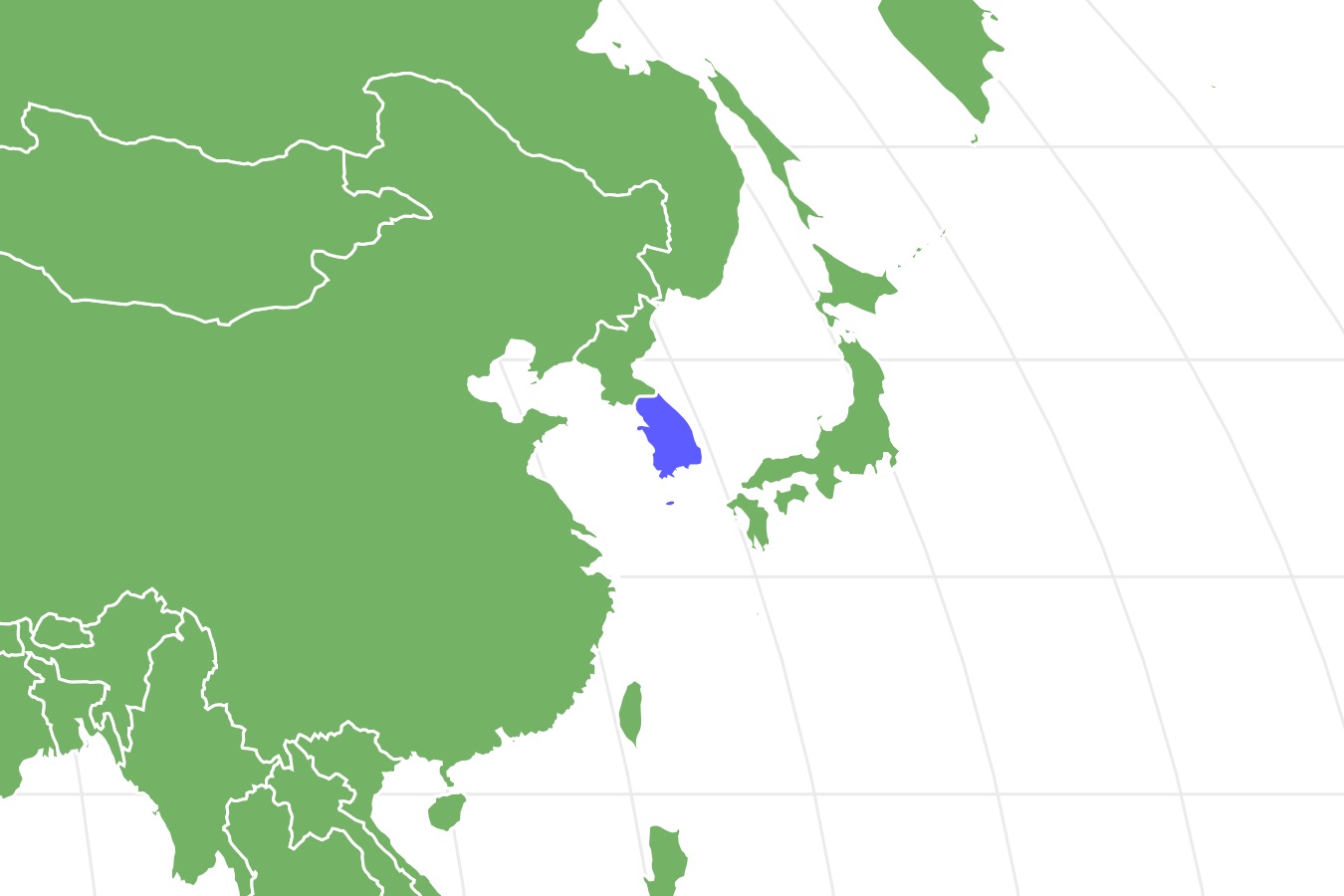Korean Jindo
Canis lupus
At the 1988 Olympics in Seoul, Jindos marched in the opening ceremonies.
Advertisement
Korean Jindo Scientific Classification
- Kingdom
- Animalia
- Phylum
- Chordata
- Class
- Mammalia
- Order
- Carnivora
- Family
- Canidae
- Genus
- Canis
- Scientific Name
- Canis lupus
Read our Complete Guide to Classification of Animals.
Korean Jindo Conservation Status
Korean Jindo Facts
- Prey
- Small animals, deer, and boar.
- Name Of Young
- Puppy
- Group Behavior
- Pack
- Fun Fact
- At the 1988 Olympics in Seoul, Jindos marched in the opening ceremonies.
- Most Distinctive Feature
- Stocky build and curly tail.
- Other Name(s)
- Jindo Dog
- Gestation Period
- 63 weeks.
- Temperament
- Active, loyal, intelligent, and territorial.
- Litter Size
- 4-8 puppies.
- Diet
- Omnivore
- Lifestyle
- Herd
- Origin
- Island of Jindo, South Korea
- Location
- Island of Jindo, South Korea
- Group
- Dog
Korean Jindo as a Pet:
- General Health
- Energy Level
- Shedability
- Trainability
- Intelligence
- Tendency to Chew
- Size
- Family and kid friendliness
- Yappiness / Barking
- Low
- Separation Anxiety
- Low
- Preferred Temperature
- Average climate
- Exercise Needs
- Moderate
- Friendly With Other Dogs
- Poor
- Pure bred cost to own
- $300-$1,000
- Dog group
- Non-sporting
- Male weight
- 35-50 lbs
- Female weight
- 25-40 lbs
View all of the Korean Jindo images!
Introduction
The Korean Jindo is an ancient hunting dog from the non-sporting group that developed over thousands of years on the Island of Jindo, southwest of South Korea. They freely roamed the countryside alongside their masters, hunting small game on their own, bringing the prey back to their owners, and hunting deer and boar in packs.
Jindos form a strong bond with their primary caregiver and are extremely loyal to and protective of that person. Their territorial nature makes them excellent guard dogs. Korean Jindos are aloof with strangers and will not take food from someone they don’t know. They are not friendly with other dogs or animals. As a family pet, they are aware of hierarchy, staying loyal to the one they perceive to be in charge.
The 2 Different Types of Korean Jindos
The Korean National Dog Association (KNDA) recognizes two different body types:
The Tonggol (or Gyeopgae) is muscular and stocky.
The second variation (Hudu or Hotgae) is slightly longer and more slender comapred to the Tonggol.
Fun Facts
- The Cultural Heritage Protection Act lists the Jindo as Natural Treasure #53 in Korea.
- At the 1988 Olympics in Seoul, Jindos marched in the opening ceremonies.
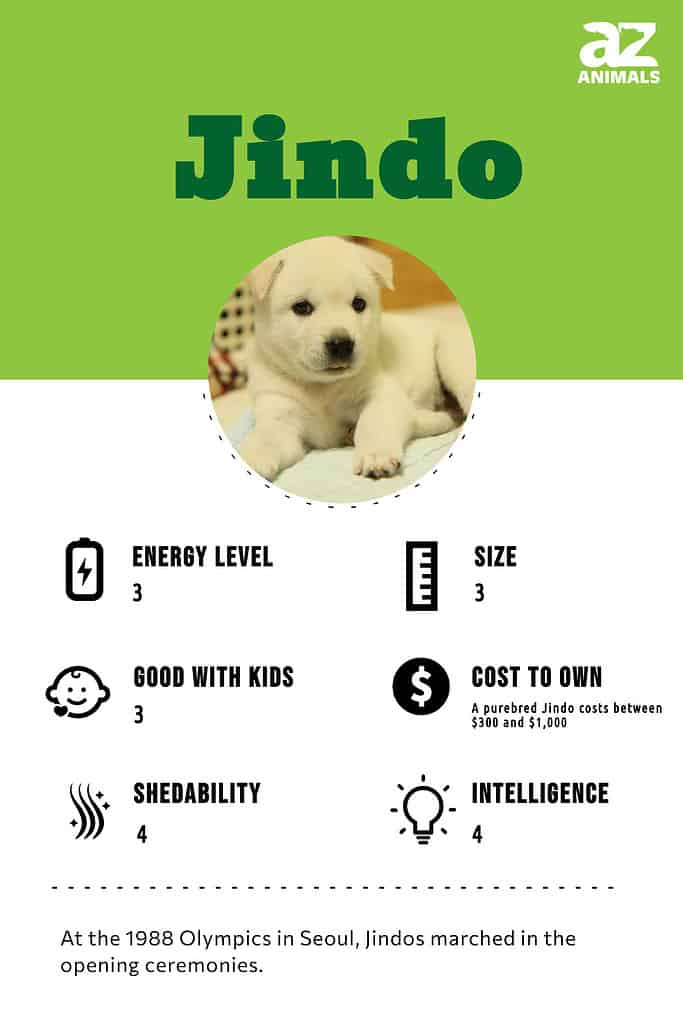
3 Pros and Cons of Owning a Korean Jindo
| Pros! | Cons! |
|---|---|
| Jindos are one-owner dogs. They are loyal and protective of that person in their life. They make excellent guard dogs. | As excellent guard dogs, they can be very territorial. Most of the aggressive tendencies they display are towards those they perceive to be intruding on their territory. |
| They are highly intelligent. Korean Jindos are capable of solving challenges without direction. They housebreak easily, too! | Apart from their owners, Jindos want to be in charge of whatever situation they’re in. They strive for dominance, and owners should know what they’re doing while training. |
| Jindos are an ancient and resilient breed. With only a few major health concerns, they have an exceptional lifespan for a medium-sized dog at 12-15 years. | Due to their intelligence and their problem-solving skills, they have strong feelings of independence. They have been known to evaluate a situation and make a decision at odds with what their owner wants. |
Origins
Off South Korea’s southwest coast, there lies an island named Jindo. Here, these canines which also bear its name lived for several centuries honing their hunting skills to impressive levels.
Jindos’ duties included hunting boar and deer. As a result, they have a powerful prey drive. They have since adjusted to modern times by obtaining employment in the military as guard dogs at military bases, where their natural distrust for stranger stands them in good stead.
This breed is related to the New Guinea singing dog as well as the endangered Donggyeongi breed.
The Best Dog Food For the Korean Jindo
Jindos are light eaters, which sometimes causes their owners to worry that they are not getting enough nutrition. They can become picky if their dish is left out for too long or if they’re bribed to eat with treats. Check with a vet if there are any eating concerns.
With a history as a hunter, the Jindo should be given a high-protein, grain-free kibble. We at A-Z Animals recommend Crave High Protein Adult Grain Free Dry Dog Food.
Size and Weight
Jindos are medium-sized dogs. The male is 18 to 25 inches tall and weighs 35 to 50 lbs. Females are 16 to 22 inches tall and weigh 25 to 40 lbs.
| Height (Male): | 18-25 inches |
| Height (Female): | 16-22 inches |
| Weight (Male): | 35-50 lbs. |
| Weight (Female): | 25-40 lbs. |
Common Health Issues
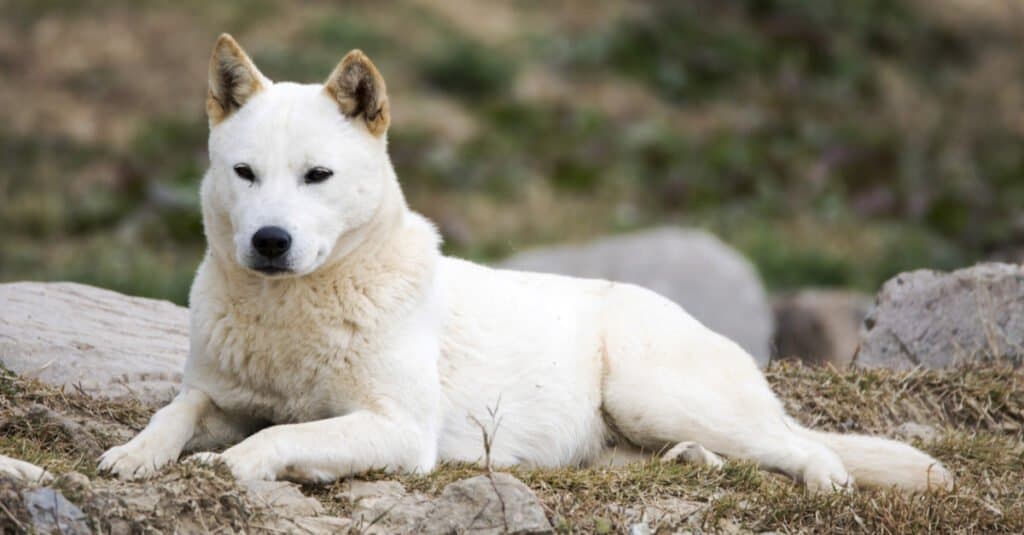
Jindos are generally healthy although they may be affected by hypothyroidism and discoid lupus
©jamongcreator/Shutterstock.com
A robust, ancient breed, Jindos are sturdy and healthy. However, two known issues may affect the Jindo: hypothyroidism, which manifests in aggression, and skin and coat issues, and discoid lupus, where the dog becomes allergic to its own tissues. Discoid lupus results in scabbing, loss of pigmentation, bleeding, and scarring around the nose and other areas.
The Korean Jindo is relatively rare and has not been evaluated on a large scale, so the breed’s true orthopedic and eye status has yet to be fully explored. Choose your dog from a reputable breeder and request complete vaccination and screening records to avoid major health issues.
Temperament

The Jindo is somewhat solitary by nature and may exhibit territorial behavior with male animals
©iStock.com/Natasha Brown
If you are looking for a loyal, protective companion, the Jindo may be your dog. They are independent hunters, discerning guardians, and loyal companions, following their owner from room to room and finding a place to curl up and watch what they are doing. The Korean Jindo is a courageous problem solver. When they are used as guard dogs, they observe, decide, and react according to their training and understanding of the situation.
As a family dog, they require special training and consideration. Family members should all be capable of interacting with the dog responsibly; the Jindo seeks a dominant place in the family hierarchy, responding to one handler. They are prey driven and not interested in interacting with anyone outside their “pack.” They are not interested in other animals and can be territorial, especially with males.
How To Take Care of the Korean Jindo
Maintenance And Grooming
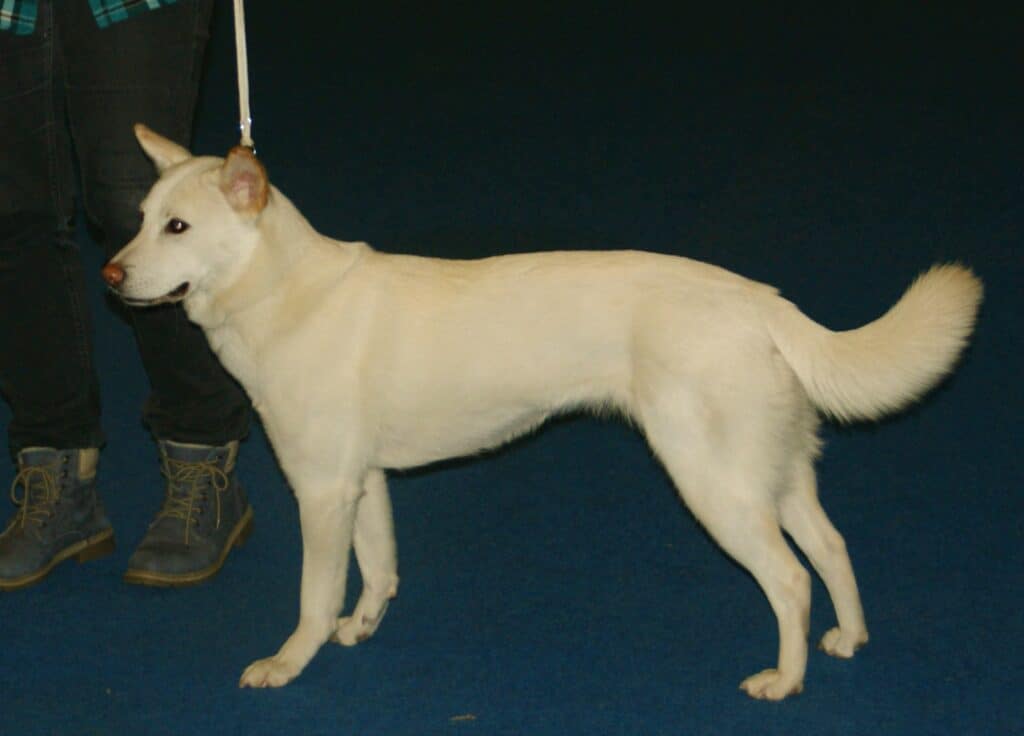
The Jindo are naturally clean and require occasional baths, regular nail trimming, and teeth brushing
©2,143 × 1,540 pixels, file size: 496 KB, MIME type: image/jpeg – License
Korean Jindos tend to groom themselves like cats, with double coats that shed grime and moisture. This coat undergoes massive shedding twice a year. Apart from that explosion of fur, the dog doesn’t shed that much and should be brushed weekly with a pin brush. They only need to be bathed occasionally, though warm baths will help during their shedding season.
Apart from this, just trim their nails regularly, brush their teeth, and check their ears frequently for wax and debris to keep them from getting infected.
Training
The Jindo is a capable and intelligent problem-solver and will only respond to one trainer. Although it is loyal to its owner, it is capable of making independent decisions and will actually judge its handler’s logic, so it’s essential that you be consistent with your training.
It can easily learn tricks, including opening doors and containers, making it something of an escape artist. If you let it run free in an enclosed area, the walls or fences must be at least 6 feet high. On the other hand, it is easy to housebreak!
Exercise
An athletic breed, the Korean Jindo requires work and some form of activity. It is good if they are part of an active household. Lure coursing and agility trials are good work for this dog. Two 30-minute walks per day are the minimum necessary to satisfy their need for motion. When walking, keep the dog on its lead (its prey drive is strong), and don’t let it walk in front; it will take that as a sign of submission on your part. Tug of war is also not recommended.
Puppies

Jindo puppies are intelligent but require training early similar to other breeds
©3,456 × 2,304 pixels, file size: 1.36 MB, MIME type: image/jpeg – License
Jindos are born in a litter of 4-8 puppies. Socialization should begin as soon as the puppy comes home because their perception of what is typical needs to be rather expansive so that they don’t react negatively to new situations. They are intelligent enough to train at that stage, too. Housebreaking the Jindo is pretty easy because they are clean dogs.
Children
The Jindo can be good with older children who interact with the dog responsibly. It likes to play with and is loyal to its family members. Due to its territorial and prey-driven tendencies, owners should watch it around small or unfamiliar children. Never leave an untrained dog alone with children.
Dogs Similar to the Korean Jindo
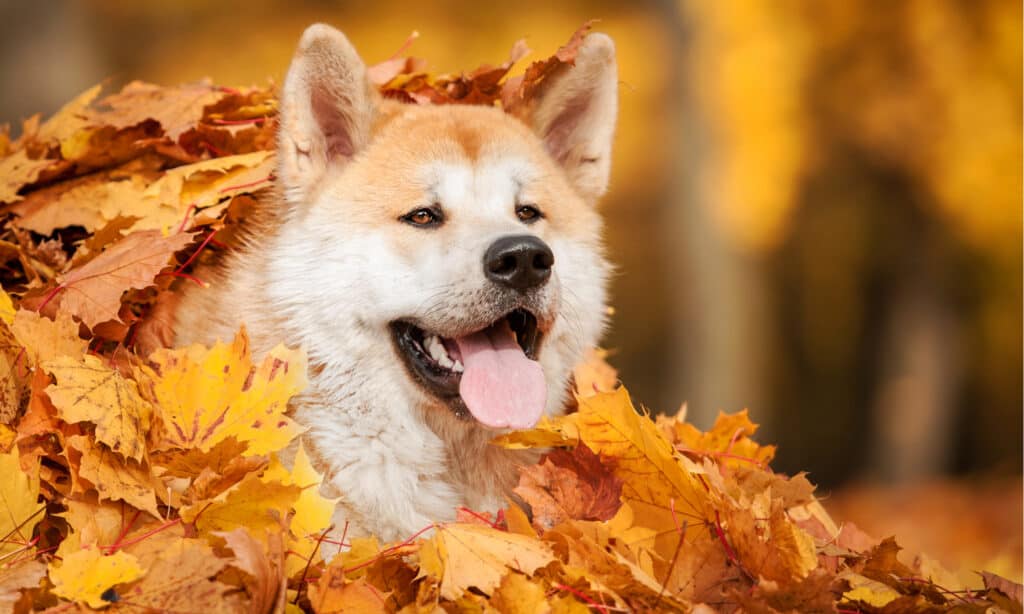
Akita are similar to the Jindo although they have a larger build
©Rita_Kochmarjova/Shutterstock.com
Shiba Inu: The Shiba Inu is a Japanese hunting dog that is physically similar to, though smaller than, the Korean Jindo. The Shiba Inu is also fastidious about its coat, like the Jindo.
Akita: The Akita also looks similar to the Jindo, though it is much larger. It is a hunting dog bred in the mountains of Japan.
Famous Korean Jindos
Jindos are known for their loyalty, homing instinct, and sense of direction. All of these were displayed in the story of Baekgu, a female Jindo who was sold in 1993 to a new owner in a village nearly 180 miles away. Baekgu didn’t attach to her new owner, ran away, and made her way back to her original owner after a harrowing 7-month journey. Her original owner changed her mind about the sale and kept Baekgu until her death 7 years later.
Popular Names for a Korean Jindo
- Baekgu
- Yong
- Shin
- Sejong
- Jin-Ho
- Shiri
- Chin-Sun
- Hyun
- Jung
- Mi-Hi
Related Animals
View all 77 animals that start with KKorean Jindo FAQs (Frequently Asked Questions)
Are Korean Jindo good pets?
Jindos are loyal and intelligent. They can make good pets if trained well, though they can be territorial. They are prey-driven, so they should be kept on a lead when not in an enclosed space. They are not good with other animals or dogs. Their suitability as a pet depends on the dog handling skills of the owner.
Are Korean Jindos hypoallergenic?
Korean Jindos are not hypoallergenic.
Is a Korean Jindo rare?
Due to their status as a Korean national treasure, it is difficult to export Jindos out of South Korea. Therefore they are pretty rare.
Is a Jindo the same as a Shiba?
Though there are some similarities between the Jindo and the Shiba Inu, the dogs are different breeds. The Shiba Inu is a smaller dog that was bred in Japan.
Would a Korean Jindo be a good choice for a first-time dog owner?
Jindos need consistent training and a steady, firm hand. Due to the Jindo’s intelligence, independence, territoriality, and need for dominance, the Jindo is not recommended for first-time dog owners.
Are Jindos good dogs for apartment living?
Jindos are naturally clean dogs and easy to housebreak. They also just like to be with their owners. They do need a lot of exercise, though, so if you want to keep your Jindo in an apartment, you should be prepared to take it on daily walks. Because of their tendency towards aloofness, territoriality, and prey drive, dog parks are not recommended.
Can Jindos be left alone?
They aren’t prone to separation anxiety, but they don’t like to be left alone for long periods of time. They really want to be with their family.
Do Korean Jindos get along with cats?
Korean Jindos don’t naturally take to other animals and are especially driven to pursue small animals. It is possible to socialize them with another animal as a puppy, but it should be of the opposite gender, and it will take a lot of work.
Thank you for reading! Have some feedback for us? Contact the AZ Animals editorial team.
Sources
- American Kennel Club, Available here: https://www.akc.org/dog-breeds/jindo/
- Korean Jindo Association of America, Available here: http://www.jindos.org/
- Wikipedia, Available here: https://en.wikipedia.org/wiki/Korean_Jindo
- Pet MD / Paula Fitzsimmons, Available here: https://www.petmd.com/dog/breeds/c_dg_korean-jindo
- Dog Breed Info, Available here: https://www.dogbreedinfo.com/jindo.htm
- Dog Pregnany Calendar, Available here: https://dogpregnancycalendar.com/korean-jindo-pregnancy-week-by-week-calendar/
- Wag!, Available here: https://wagwalking.com/name/jindo-dog-names
- Dog Breeds List, Available here: https://www.dogbreedslist.info/all-dog-breeds/korean-jindo-dog.html
- Bark Post / Dr. Katy Nelson, Available here: https://post.bark.co/breeds/jindo-guide

